1. This documentation is a couple years old, and some of the technology it discusses is even older.
3. All throughout the excerpts that follow you need to tune out all the filler that provides the motivations and justifications for advancing this research and development work and simply recognize and accept that all of that only sounds good, that none of it is really needed, and that it is all an EXCUSE that only makes any sense in the context of a global fear frenzy that has been manufactured out of nothing -- to provide a reason to do this at all.
4. Keep in mind that this nanotech is nefarious SPYWARE, fraudulently necessitated by the faux threat of pandemic health emergencies. That "bio-security" is a monumental ruse.
And most importantly, understand that the technology being discussed and reviewed is NOT intended solely for use by doctors to help them provide better care for specific patients with specific ailments. In other words, we are not talking about new advancements that add to a physicians tool bag, that have become available to them for use on a case by case basis, to help them overcome difficult circumstances in certain situations, or as they see fit. This monitoring in being accomplished by "wet-ware" that has been installed in everyone, including you and I, and despite the many serious health problems associated with its use, this installation was done WITHOUT YOUR KNOWLEDGE OR CONSENT!
5. In the mad bio-security world that is driven by a fear of invisible pathogens, whatever their origin is said to be, it is now possible to conjure "evidence" that YOU are a potential threat, and this is what is so dangerous about all of this. Eliminating that threat, even if it means eliminating you, is going to be seen as OK if whatever health problem they can point to can be used to single you out as some sort of threat or risk. Everything is on the table as a means to contain what will be framed as protecting "the greater at-risk population."
Everyone adding to the noise around vaccines and biological weapons is having the wrong discussion. None of them are talking about the actual weapon here, which has already been deployed in everyone whether they managed to escape being vaccinated or not. Its true, the vaccines are harmful, and this is why, but its not just about toxic poisons, it is why those toxic poisons were introduced to begin with.
Recall back to that farce of a human trial Pfizer pretended to do before releasing their vaccines on everyone. Remember that they were "experimental" and that there were specific endpoints stated in the vaccine documentation Pfizer provided. Nobody argues this now, that there was an experiment going on, but what was it?
That is where everyone screaming about vaccines kind of dropped the ball. It was assumed the experiment had to do with how humans handled the vaccine. And to some extent it was, but really it was about how the vaccine changed them, trans-humanized them. Really, it was about what could be done with those people if they survived being poisoned, and that is what this documentation discusses rather openly if you properly understand what you are reading. And there is a huge mountain of documentation proving this at the IEEE, a place very few people thought to look.
Still some people simply looking at blood samples with a simple microscope are beginning to surmise some of this.
DR. ANA MIHALCEA - THEY HAVE PUT ARTIFICIAL LIFE INSIDE OF THREE BILLION PEOPLE...
https://www.bitchute.com/video/qsw9ThL5fbrc/
Myocarditis is just the tip of the iceberg. HERE IS THE REST OF IT!
Picking up where we left off with Table 2:
"Bluetooth (LE) Low Energy technology was introduced to wirelessly connect small low power devices to mobile terminals. This technology is ideal to be integrated with implants for healthcare applications as it supports ultra-low power consumption [102]. It contains tiny Bluetooth radio to actively send and receive messages from nearby smartphone devices. The transmission range of Bluetooth LE is up to 10 m, the data rate is 1 Mbps and the frequency band is 2.4 GHz ISM [103]. Pairing time with other devices is in milliseconds, which is appropriate for alarm and emergency conditions in healthcare applications [104]."
b: ZIGBEE
"ZigBee has an active transmitter able to communicate with mobile devices over a distance of 10-100 m. Zigbee is considered the most cost-effective technology due to its low power and low data rates. ZigBee can operate on three ISM bands with data rates from 20 Kbps to 250 Kbps [104]. Although ZigBee provides a large transmission range, it is not a good candidate for continuous health monitoring applications due to its low data rates [101]."
If Zigbee is not a good candidate for continuous health monitoring applications that begs the unanswered question of what it IS good for. That is what I want to know. It sounds to me as if this would useful when you want to trigger some kind of nano-system event at a distance.
c: IEEE 802.15.6 STANDARD
"The rapid popularity of Wireless Body Area Networks (WBANs) and Consumer Electronics called for a standard communication medium to address the special needs of the WBANs such as low power, low cost, low complexity, high throughput and short-range wireless communication in and around the human body. IEEE standards association established the IEEE 802.15 Task Group 6 for the standardization of WBAN [105], [106]. It quotes: ‘‘The IEEE 802.15 Task Group 6 (BAN) is developing a communication standard optimized for low power devices and operation on, in or around the human body (but not limited to humans) to serve a variety of applications including medical, consumer electronics personal entertainment and other IEEE 802.15 WPAN Task Group 6 Body Area Networks. 2011]. IEEE.802.15.6 has different frequency bands in different countries ranging from 16- 27 MHz [107]. "
Were you aware WBAN's were so popular? I wasn't. If it is that popular don't you wonder why this vocabulary isn't more common? Maybe its because the idea of " high throughput and short-range wireless communication in and around the human body" isn't exactly advertised.
"Medical Implant Communications Service (MICS) band is a licensed band used for implant communication and has the same frequency range (402-405 MHz) in most of the countries [105]. MICS band is suitable to be integrated for bio-cyber interface as it defines protocols that are compatible with system requirements of bio-cyber interface."
The key word here is "integrated".
"IEEE.802.15.6 can operate within a transmission range of 3 m with data rates up to 10 Mbps [108]. IEEE.802.15.6 has also been recognized to be used as a standard for Human Body Communication (HBC). HBC uses the human body as signal propagation medium, therefore certain concerns must be taken into account such as increased mobility of the patient, lower power consumption, small battery size yet life to span around a time several months, and management to aggregate burst data in presence of continuous triggers from physiological data. Considering these HBC concerns [109] proposed a medium access method for statistical frame-based time division multiple access (S-TDMA) protocol that demonstrates lower data latency, lower power consumption, and higher transmission efficiency."
And here we have been encouraged to believe "shedding" was a thing. Wake up. People are not shedding anything physical, they are electronically TRANSMITTING!
"NFC is a passive communication designed to operate in the ultra-low transmission range of up to 20 cm. NFC technology contains NFC tag similar to the RFID tag, which is powered by a readout device. Communication in NFC requires devices to touch each other or be in close vicinity to each other. Smartphone transmits power wirelessly to resonant circuits through inductive coupling which turns ‘‘ON’’ the NFC tag. Once the transmission session is complete, the tag is marked as ‘‘OFF’’ and becomes unreadable [110]. This technology is ideal for implantable devices with a low power source as the communication is powered by the reader device (in our case smartphone). Ultra-Low transmission range in NFC is not a drawback, rather it is a strength as it provides rapid connection [101]."
Here you have a reference to a situation in which a healthcare provider uses a smartphone or similar device to "read" biometric telemetry off of some sort of medical implant, of course the implant in this case goes unidentified, leading you to maybe envision a doctor collecting data from a pacemaker or something.
e: RFID (ISO/IEC 18000-6)
"RFID is a passive wireless technology that consists of a transponder (tag) to be read by an RFID reader. RFID based implants are feasible in situations where battery supply is a major issue [101]. Entire transmission in passive RFID systems is powered by the reader side [111], which in our case can be RFID reader enabled smartphone devices. The read range of RFID is 1- 100 m with the data rate of 10- 100Kbps [104]. Battery-powered RFIDs with active radio transmitters are available which comes with a high cost yet low data rates."
Think about this. They are not talking about an anti-theft sticker on some retail product. If the RFID implant is a nanoscale device floating around in your bloodstream, then whatever it says about you can be read by a reader device from as far as three football fields away.
"Bio cyber interfaces need a continuous power supply for data collection, processing, and transmission. The battery is mass vise the largest unit in the bio-cyber interface and other body implants. Although considerable progress has been done in lithium rechargeable batteries, yet they cannot keep pace with the novel technology requirements and size constraints. Miniaturization of a battery source, energy harvesting methods based on human body movements, and wireless battery recharge techniques have been explored by researchers of MIT for implants in Wireless Body Area Networks (WBANs).
Don't think in terms of actual batteries, think in terms of nano-crystalline particles that run on a piezoelectric effect that can be harvested from any number of sources, including the ambient wireless radiation soup we all walk around completely immersed in. In the next paragraph some examples of those sources of energy are given.
"Evanescent waves have been considered in [112] to wirelessly power the electronic devices over a short distance. Other efforts include solar rechargeable batteries [113], piezoelectric nanogenerators [114], micro-supercapacitors [115] and endocochlear potential-based bio batteries [116]. Implantable devices in IoBNT need a continuous power supply and prolong battery life, for this purpose mechanism has been investigated to scavenge power supply from the epidermal layer of the wearer [116]. These energy scavenging batteries are called biofuel cells (BFC), which convert chemical energy into electrical energy through biocatalytic reactions [117]–[119]. Researchers from the University of California San Diego have demonstrated an epidermal BFC [120] to scavenge continuous energy from human perspiration. Lactate is used as biofuel as it is present in human sweat in an abundant amount [120]. Similarly, energy scavenging techniques from the human body can be adapted for power supply in the bio-cyber interface. A detailed energy model for nanoscale devices has been demonstrated in [121] which discusses the power consumption of each component in the nanonetwork."
This next section draws our mind back to the idea of "smart stickers" and the like, some of which also come with toxicity problems. Compared to the nanotech that accomplishes similar functions anything involving a sticker you have to glue on somehow is stone-age tech by comparison.
D. ADHESION SYSTEM
"This section briefly discusses the patch material, as biocyber interface is envisioned to be a wearable/stick-able bio-electronic device. The adhesive material for the patch is under high interdisciplinary research investigation as human skin is extraordinarily stretchable ( > 100% where is the strain), highly rough (superlative height 40 µm), and generally covered with sweat and hairs [122]. Hence, delivering adequate adhesion of skin patches against human skin persists to be a challenging task. Adhesion materials should be carefully chosen to prevent issues like cytotoxicity (i.e., condition of being toxic), skin contamination, damages, risks of infection, and loss of wet adhesion make them less effective. Adhesion materials using electronic materials are extensively reviewed in [35] and bio-inspired approaches for adhesion like gecko-/beetle-inspired mushroom-shaped architectures, endoparasite-like microneedles, octopus inspired suction cups and slug-like adhesive with energy dissipation layer, has been keenly investigated in [122]. Special measures should be taken into account while selecting the adhesive material to prevent data loss and wireless connection due to strain and physical pressure on the patch while patient movement, wrinkling of skin or other factors."
And here is where they finally reveal where they are with all of this:
"There exist a few proposals in the literature that present interface either using nano EM or MC communication. In the nano EM domain [123] have proposed an architecture of nanonetworks-based Coronary Heart Disease (CHD) monitoring system. The proposed model consists of nanomacro interface (NM) and nanodevice-embedded Drug Eluting Stents (DESs), termed as nanoDESs. The algorithm exploits the periodic change in mean distance between a nanoDES, inserted inside the affected coronary artery, and the NM, fitted in the intercostal space of the rib cage of a patient suffering from a CHD utilizing THz band.
"Another paper proposes a straight forward communication scheme utilizing the TeraHertz Band. The architecture consists of nano nodes and nano router, deployed in the dorsum of the human hand. Nano nodes circulate in the blood vessel for the collection of medical data and transmit the aggregated data to the nano router. Nanorouter then transmits the data to BAN (Body Area Network) device through THz band communication, which is then relayed to the Internet."
"Some theoretical models have adopted MC paradigm for the design of bio-cyber interface device. For example, authors in [64] have conducted a wet-lab experiment by utilizing artificially synthesized materials as an interface between the biological and electrical world. The proposal employs optical sensitive molecules(pH rodo molecules) that activate upon expression of fluorescence through fluorescent microscopy."
These are NOT theoretical models anymore! "Wet-lab" experiments are in vivo experiments involving people…
"The above-mentioned proposals that utilize nano nodes and nanoDES in THz communication, may not be biocompatible due to the non-biological nature of these devices. Secondly, the use of external devices like a fluorescent microscope can also cause mobility issues for the patient, which negates the whole notion of IoBNT."
…and they admit the fact that such techniques "may not be biocompatible", a euphemism for HARMFUL.
"A novel hybrid approach is presented [30], which suggests utilizing MC based communication inside the human body for its biocompatible and noninvasive properties. The MC can communicate with graphene-based nanosensor, implanted over the human body for communication with external devices. The nano micro interface will, therefore, consist of a THz based antenna and micro/macro antenna. The idea is to limit the non-bio devices inside the human body and to read the intra-body parameters efficiently outside the body"
And finally they spill the important bit about all this being done with "graphene-based nano-sensors".
"Traditional methods of drug delivery through oral intake of medicine and via injections are now quickly being replaced by transdermal drug delivery patches."
"Fourth-generation transdermal drug delivery systems [133] are now capable to release controlled amounts of the drug upon receiving commands wirelessly through the internet."
1) SECURITY CONCERNS IN ELECTRONIC TATTOOS AND TRANS DERMAL PATCHES
"Electronic tattoos and transdermal patches can be exposed to security threats as they are continuously connected with the wireless technology. The following are some of the threats that electronic tattoos and transdermal patches may encounter."
a: WIRELESS COMMUNICATION RISKS
"Electronic tattoos and transdermal patches need continuous wireless network supply in order to receive and send information to the healthcare provider. Mainly the electronic tattoos are connected with a gateway device (smart phone) that relays the information over the internet. In the currently published literature for electronic tattoos, it is noticed that most of the proposals have used Bluetooth or BLE as communication mechanisms between electronic tattoo and gateway device. Bluetooth technology works within close proximity and is considered safe as attacker must be present within the patient’s vicinity to launch an attack. However, Bluetooth version 5.0 has a transmission range of up to 400m moreover, the range can be magnified up to a mile through omni directional antennas.
Researchers from Singapore University of Technology and design have discovered 12 different Bluetooth bugs which can affect 450 type of IoT devices including implantable medical devices. Moreover, the security flaw named ‘‘SweynTooth’’ associated with BLE can crash the device, deadlock the device or bypass security to access device functionality.
What if the "device" they mention is not some kind of smart Band-Aid, but YOU?
Another critical threat to Bluetooth technology is Blueborne attack. In this attack, hackers infect the devices with malwares and gains access to the device to execute malicious operations [134]."
And there it is, the nugget of truth at the heart of this discussion: We are left to wonder who the hackers are in this case, but does that really matter if the whole point is to create a situation in which any human being can be covertly attacked by anyone with a motive and access to their unsecured biology?
b: PHYSICAL HARM
"The electronic tattoos currently manufactured are tested rigorously to withstand mechanical deformation caused by external strain. However, in cases of long term use and extreme physical stress conditions, the device abilities might be degraded and cause unwanted behavior. The bio-electronic devices which are presently designed in the form of electronic tattoo and implantable patches that do not require any surgical procedures to affix on the human body. Non-medical professionals can apply these devices easily on human skin like stickers. This non-surgical relaxation can be exploited by local attackers to replace the bio-electronic device with an illegitimate device on an unconscious patient. The illegitimate device now becomes part of the communication and can launch several passive and active attacks like eavesdropping, replay attack, and data modification, etc."
I personally find it interesting that the example given involves attacking an unconscious patient. It reminds me of those people who were given covid shots against their express wishes by members of the Cult of Covid in all kinds of hospital settings whenever they were exposed and vulnerable.
Countermeasures:
"Some of the possible countermeasures for above mentioned attacks are Tamper-proofing and self destruction: Use of tamper proof package for sensing devices and enable self destruction mode upon countering an intruder attack. Minimize information leakage: Protective measures like generating artificial noise, shielding and adding randomized delay can be taken to minimize information leakage. [135] Run-time attestation: Generation of proof about updation of firmware by a remote entity. [135]."
These all sound like weak attempts to create some pretense of responsibly addressing what they see as security gaps that completely ignores the fact they are associated with nanotech that should not even be there in the first place. However, mentioning disruptive effects that can be caused by generating artificial noise, shielding and adding randomized delay might be important clues if someone was looking for a way to defeat the operability of these systems.
B. RFID TAG SENSORS AS BIO-ELECTRONIC DEVICE
Skipping through this… Remember what I said at the beginning, about every macro-scale tag or tool having a nano-scale duplicate.
"The role of RFID sensors in envisioned healthcare applications IoBNT is promising due to their easy integration with implanted interfaces for communication with the Internet."
"RFID is a wireless technology that utilizes RF signals to identify objects with RFID tags. RFID system has two components: a tag which is a microchip to store electronic information and radio antenna to receive signals."
"Passive RFID tags are ideal for IoBNT applications…"
"RFID technology can be used as sensors [148], for sensing applications of IoBNT and can be used as a bio-electronic interface on its own. RFID antennas that are sensitive to environmental changes like gas [149], moisture [150] and temperature [151], have already been developed."
"The sensing capabilities of the RFID system can be exploited to measure the chemical and biological values of the human body. 13.56 MHz) or ultrahigh-frequency (UHF, 400 MHz) bands, has proven adequate in powering the adaptive threshold rectifier. The HF band is for patch sensors, whereas the UHF band supports’ implantable sensors [30]."
"The envisioned Bio-electronic interface with RFID enabled technology is likely to have the following components to be operational in the IoBNT domain. RFID sensor tags that contain chemically coated thin- film resonant sensing antenna for sensing target chemical substances in the environment. Recent RFID tags are thin and flexible, allowing them to be embedded easily in the human body for health monitoring purposes [37]."
"Novel methods for the fabrication of electronic devices through inkjet printing are getting research attention in Consumer Electronics (CE). Nanomaterials like graphene, carbon nanotubes, silver, gold and copper nanoparticles, conductive polymer and their based materials are used as inkjet ink to print electronic devices."
"A comprehensive review of inkjet-printed nano-material based flexible radio frequency identification (RFID) tag sensors for the Internet of nano things has been presented in [38]."
You know when you go into some hospital for a routine screening and they give you some dye in a cup and tell you to drink it? Yeah. Just imagine what all could potentially be in that.
Now watch the utterly absurd length they will go to, to come up with bullshit uses for this tech. It seems like they will say anything to sell it.
"Another smart health proposal using RFID technology has been presented in [62], where a smart bandage manages chronic wounds by wirelessly transmitting wound pH status to an external readout unit in the smartphone, using radiofrequency identification (RFID). This is a lightweight, noninvasive bandage proposal that saves the patient from regular hospital visits for dressing change."
Are we really "saving the patient" here? Or are we just taking humans out of healthcare and eliminating personal care by eliminating nursing?
1) SECURITY CONCERNS IN RFID BASED BIO CYBER INTERFACE
"RFID tags, when used with interconnected devices in environments like IoT and IoBNT can be easily compromised by attackers. Following are a few possible security threats that must be considered when using RFID based technology as bio cyber interfacing option [135]. "
Duh.
Welcome to the Brave New World,
where everything that can go wrong with your computer
can now go wrong with YOU!
Aren't you glad someone asked you if you wanted this
before force migrating you into accepting this "upgrade"
to the latest and greatest nano biological system architecture?
Remember the "Blue Screen of Death"?
[THE EVIDENCE]
Part Five coming soon…
If you are just finding my blog please be sure to also check out two other contributions I made:
HOW TO REVERSE VACCINE INJURIES:
http://estateartistry.com/blog/reversing-vaccine-injuries
CANCER CURE:
http://estateartistry.com/blog/cure-your-cancer-by-christmas
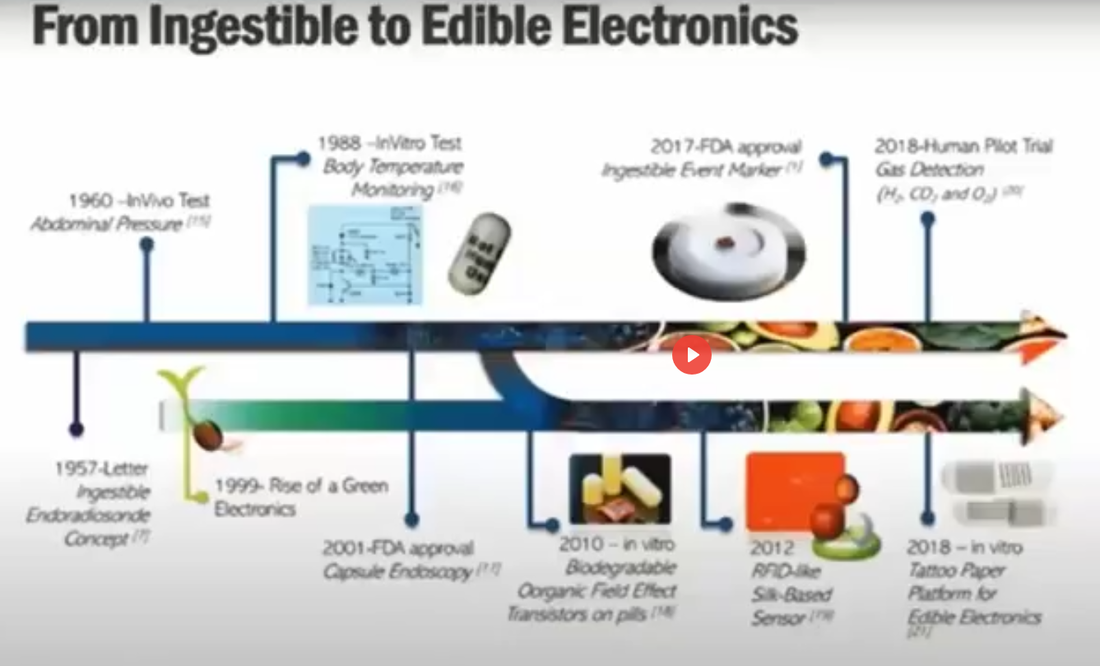

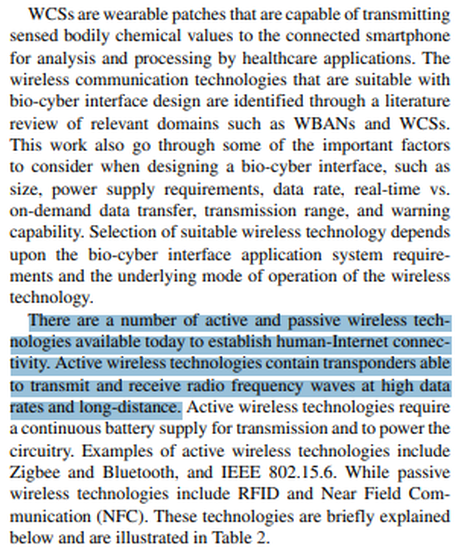
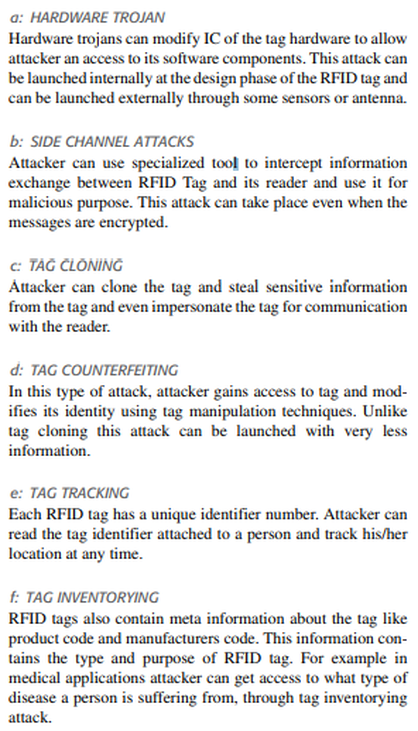
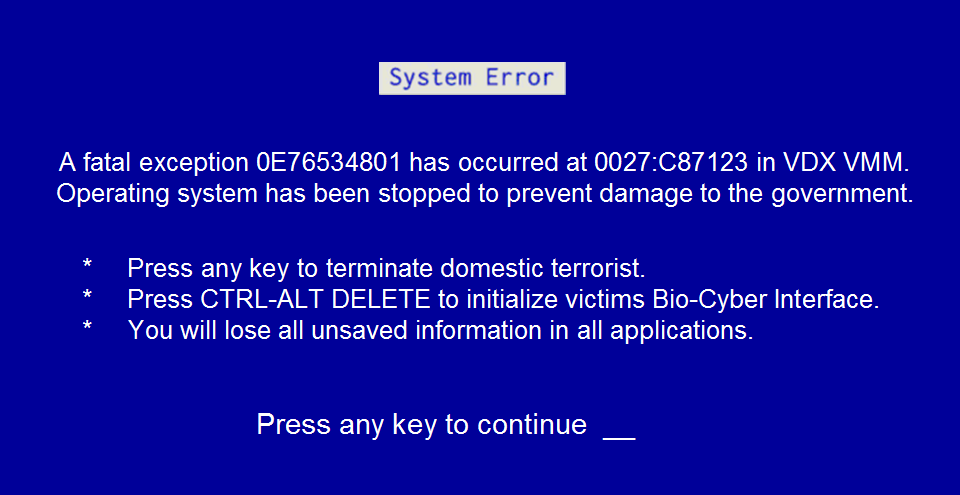
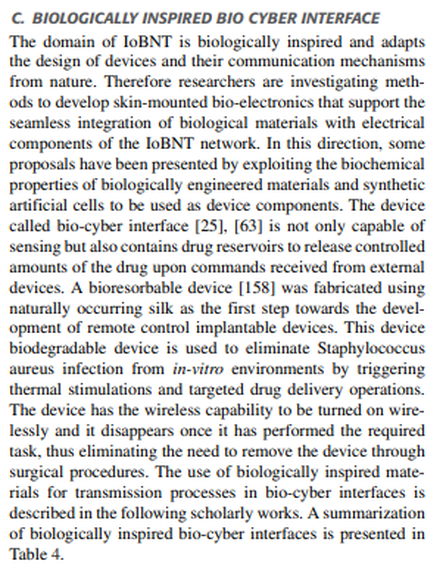

 RSS Feed
RSS Feed